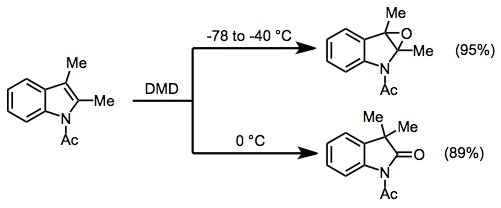Epoxidations
Dioxiranes are electrophilic oxidants that react more quickly with electron-rich than electron-poor double bonds; however, both classes of substrates can be epoxidized within a reasonable time frame. The mechanism of epoxidation with dioxiranes likely involves concerted oxygen transfer through a spiro transition state. As oxygen transfer occurs, the plane of the oxirane is perpendicular to and bisects the plane of the alkene pi system. The configuration of the alkene is maintained in the product, ruling out long-lived radical intermediates. In addition, the spiro transition state has been used to explain the selectivity in enantioselective epoxidations with chiral ketones. [1]
Diastereoselective epoxidation may be achieved through the use of alkene starting materials with diastereotopic faces. When racemic 3-isopropylcyclohexene was subjected to DMD oxidation, the trans epoxide, which resulted from attack on the less hindered face of the double bond, was the major product. [1]
Epoxidations of electron-rich double bonds yield intermediates of Rubottom oxidation. Upon hydrolysis, these siloxyepoxides yield α-hydroxyketones. [1]
Electron-poor double bonds take much longer to epoxidize. Heating may be used to encourage oxidation, although the reaction temperature should never exceed 50 °C, to avoid decomposition of the dioxirane [1]
Alkenes bound to both electron-withdrawing and -donating groups tend to behave like the former, requiring long oxidation times and occasionally some heating. Like electron-poor epoxides, epoxide products from this class of substrates are often stable with respect to hydrolysis. [3]
In substrates containing multiple double bonds, the more electron-rich double bond tends to be epoxidized first. [4]
Epoxidations employing aqueous oxone and a catalytic amount of ketone are convenient if a specialized dioxirane must be used (as in asymmetric applications) or if isolation of the dioxirane is inconvenient. Hydrolytic decomposition of the epoxidation product may be used to good advantage. [5]
Diastereoselective DMD epoxidation of a chiral unsaturated ketone was applied to the synthesis of verrucosan-2β-ol. [6]
Enantioselective dioxirane epoxidation is critical in a synthetic sequence leading to an analogue of glabrescol. The sequence produced the glabrescol analogue in 31% overall yield in only two steps. [7]
Comparison with other methods
Dioxirane epoxidation compares favorably to related peracid oxidations. Peracids generate acidic byproducts, meaning that acid-labile substrates and products must be avoided. [8]
Some methods are well-suited to the oxidation of electron-rich or electron-poor double bonds, but few are as effective for both classes of substrate as dioxiranes. Weitz-Scheffer conditions (NaOCl, H2O2/KOH, tBuO2H/KOH) work well for oxidations of electron-poor double bonds, [9] and sulfonyl-substituted oxaziridines are effective for electron-rich double bonds. [10]
Metal-based oxidants are often more efficient than dioxirane oxidations in the catalytic mode; however, environmentally unfriendly byproducts are typically generated. In the realm of asymmetric methods, both the Sharpless epoxidation [11] and Jacobsen epoxidation [12] surpass asymmetric dioxirane oxidations in enantioselectivity. Additionally, enzymatic epoxidations are more enantioselective than dioxirane-based methods; however, such methods often suffer from operational difficulties and low yields. [13]
Asymmetric epoxidations with dioxiranes
Chiral ketones react with oxone to give chiral dioxiranes. This fact underpins enantioselective epoxidations. [14] A popular implementation is the Shi epoxidation, which uses a fructose-derived chiral ketone.
Practical considerations
Dioxiranes may be prepared and isolated or generated in situ from ketones and potassium peroxymonosulfate (Oxone). In situ preparations may be catalytic in ketone. The functional group compatibility of dioxiranes is limited somewhat, as side oxidations of amines and sulfides are rapid. Baeyer-Villiger oxidation may compete with dioxirane formation.
Dioxirane itself (CH2O2) is not useful. Instead, the substituted dioxiranes dimethyldioxirane (DMD) and methyl(trifluoromethyl)dioxirane (TFD) are commonly employed for synthesis.
DMD and TFD may be generated in situ using conventional glassware with a two-phase system consisting of a buffered aqueous solution of oxone and a solution of substrate in an organic solvent. Such a two-phase set up is called for since oxone is insoluble in organic solvents. Mechanical stirring and/or polar organic solvents such as acetone are employed often. [15]
The salt KHSO5 is often referred to as oxone, but they are not the same. Oxone refers to the triple salt 2KHSO5·KHSO4·K2SO4, which is more shelf-stable than KHSO5. [16]
Epoxidations using isolated dioxirane (e.g. DMD or TFD) avoid the need for aqueous buffering. The volatile dioxiranes DMD and TFD can be isolated via distillation. Once isolated, dioxiranes can be kept in solutions of the corresponding ketones and dried with molecular sieves. These solutions are suitable when substrates or products are sensitive to hydrolysis. [17] Catalytic dioxirane oxidations do, however, require water.















